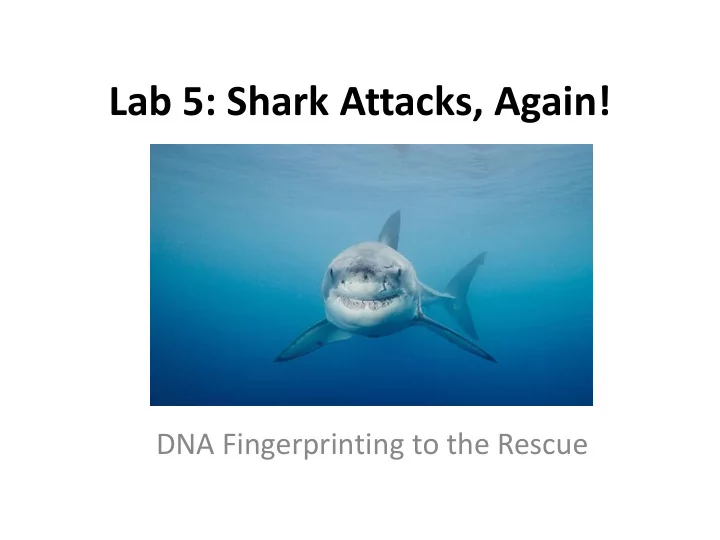

Lab 5: Shark Attacks, Again! DNA Fingerprinting to the Rescue
Notebook Lab Objectives • Develop an understanding of the basic techniques used to study genetic polymorphisms encoded in DNA • Gain familiarity with Restriction Fragment Length Polymorphisms (RFLPs) and their use in the study of biodiversity • Apply RFLP analysis to genetic fingerprinting and shark identification • Use critical thinking to solve problems through DNA analysis
Reef Point, Australia
Scenario • Series of shark attacks at a remote Australian surfers’ paradise, Reef Point Beach • Reef Point Bay is a mating point for spotted seals (prey for sharks) • Warmer waters and climate change to blame • Determine whether the attacks were committed by the same shark or more than one through forensic analysis of DNA samples
Shark Facts • Average yearly fatalities from shark attacks worldwide is just 2 • Humans kill approximately 2 million sharks per year
Notebook Materials • 2% agarose gel with Gel Green Nucleic Acid Stain • 1X TBE (Tris-borate EDTA) buffer • 4 shark DNA samples for fingerprinting analysis • 1 tube of DNA molecular weight marker (DNA Ladder) • 6X gel loading dye
Notebook Gel Preparation • Prepare 50 mL of a 2% agarose gel (In your notebook, show calculations for amount of agarose powder required and dilution of 20X TBE buffer)
Notebook Gel Green Dilution for Gel • Gel Green is 10,000x concentrated • 1X concentrated within the gel (Show calculations for dilution for Gel Green in your lab notebook)
Notebook PreLab Questions • What is a DNA fingerprint? • What are restriction enzymes? • What is a restriction length polymorphism (RFLP)? • How are RFLPs used as a DNA identification method?
Gel Electrophoresis Applications • DNA fingerprinting for many purposes • DNA sequencing (old school method) • Paternity testing • Examine evolutionary relationships among organisms (similarities and differences) • Diagnose genetic disorders or gene testing • Determination of impurities in a sample
DNA Fingerprinting
VNTRs • Variable number of tandem repeats
Restriction Enzymes Cut DNA • Cut DNA molecules at or near a specific sequence of nucleotides • Creates smaller fragments of DNA
Restriction Enzymes Cut DNA • Use gel electrophoresis to compare multiple samples of DNA • Similar DNA samples have similar restriction sites and will produce fragments of similar sizes
DNA Fingerprinting • A DNA Fingerprint represents an individual’s unique genetic profile • Analyze variable regions in DNA in order to identify individuals • Scientists usually focus on regions of DNA that are known to typically vary across individuals • Isolated variable regions of DNA are then separated by size using gel electrophoresis
DNA Fingerprint
DNA Sequencing
Forensics • Restriction enzymes and gel electrophoresis are used to create DNA fingerprints to analyze DNA samples from crime scenes
Paternity Testing • The pattern of DNA fragments (produced by the restriction enzyme digest) is compared and if the child's DNA looks like a combination of the two parents' DNA, then the child is theirs
Evolutionary Relationships • Which of the species, X or Y, is more closely related to species Z?
Diagnose Genetic Disease • Molecular diagnosis of a particular inherited disease
Notebook Reagents • DNA from Crown Beach ( CB ) – 15 µL • DNA from Doom Cove ( DC ) – 15 µL • DNA from Wave Crest ( WC ) – 15 µL • DNA from Hoppa-Hoppa ( HH ) – 15 µL • DNA Ladder ( LAD ) – 15 µL • 6X Gel Loading Dye ( LD ) – 20 µL
Notebook Procedure Overview • Add 3 µL of 6X Gel Loading Dye ( LD ) to each DNA sample (including the DNA Ladder) • Mix well by gently tapping the tube on the lab table • Load DNA samples onto the gel, from left to right, as follows:
Notebook Results • Transfer the picture of your gel into your lab notebook using the template provided
Ladder
Notebook Analysis Questions 1. Why is there more than one DNA band within each sample analyzed? 2. What caused the DNA to become cleaved (broken up) in small fragments? 3. Examine the shark DNA from Crown Beach. How many restriction sites do you think existed within this sample of DNA? (assume a single linear piece of DNA was the starting material)
Notebook Analysis Questions 4. Based on your analysis of the DNA samples, how many sharks were involved in the recent Reef Point attacks? Explain if one or more sharks were involved, and which attacks if any may have involved the same shark. 5. What chemical helps make the DNA visible when exposed to UV light?
Recommend
More recommend